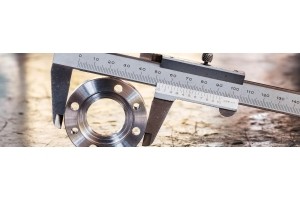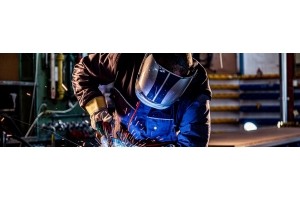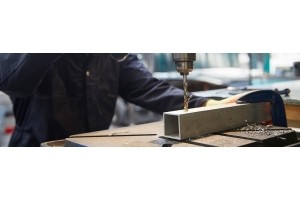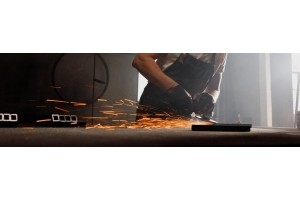- Material
-
- Aluminium 61
- Brass 8
- Stainless Steel 8
- Galvanised Steel 1
- Mild Steel 1
What Are The 6 Basic Metalworking Tools You Should Know
Every project begins with preparation. No matter whether it involves repairing a part, creating a component, or working with an aluminium plate for the first time, the process is the same. Yet, beginners often face delays because they’re unsure which basic metalworking tools they really need. Measuring by eye leads to inaccuracies, and drilling without guidance risks damaging the material. Plus, unsecured sheets reduce precision and safety.
In 2024, the Health and Safety Executive (HSE) stated that 604,000 working people sustained an injury at work, according to the Labour Force Survey. Using the correct six categories of tools cuts down risks and creates a reliable foundation for safe and accurate work.
These basic categories include:
- Measuring & marking
- Cutting
- Clamping
- Shaping & finishing
- Drilling
- Proper maintenance
With this structure in place, even entry-level projects can be completed to a consistent standard. For a full overview of the metals and profiles available to support your work, see our shop by category page.
Measuring & Marking Tools for Accuracy
Accurate marking is the first stage of every project. Mistakes at this point carry through to cutting and drilling, increasing costs and undermining safety. Reliable measuring and marking tools establish clear guidelines. This helps ensure that each stage of the workflow remains controlled and consistent.
Essential tools include:
- A steel ruler or tape measure for quick and accurate length and width checks.
- A combination square checks right angles and helps draw straight lines on sheets and bars.
- A centre punch for creating drill guides that reduce the chance of bit slippage.
When working with a cut-to-size aluminium plate, apply a punch before drilling. Doing so prevents drill drift and helps protect the material surface. Health and Safety International (HSI) says that poor preparation before drilling often leads to hand tool accidents in the US. Accurate marking helps lower risks and prolongs the life of cutting and drilling tools.
For guidance on selecting the most suitable material for your project, view our metals by material page.
Cutting Tools for Clean Edges
Cutting is one of the most frequent operations in metalworking. Using the right tools for the material’s type and thickness helps reduce waste, increase safety, and result in a clean finish. HSE advises that cutting tasks should only be carried out with equipment appropriate to the job and under secure conditions.
Standard beginner-friendly tools include:
- A hacksaw for cutting rods, bar sections, and sheet metal in smaller projects.
- Tin snips or shears for thin aluminium plate or sheet, producing clean, controlled lines.
- An angle grinder with a cutting disc for efficient straight or curved cuts.
Our cut-to-size service further reduces the need for manual cutting. Aluminium, brass, stainless steel, galvanised steel, and mild steel are all processed on-site with tolerances of plus or minus 2 mm. This service saves time, minimises waste, and provides consistent accuracy from the outset.
Clamping & Holding Tools for Stability
Stable workpieces are essential for safe and accurate results. Clamping tools secure metals in position, preventing movement during cutting, drilling, or shaping. HSE records that slips and loss of control with hand tools account for 17% of workplace injuries. Using clamps and vices reduces this risk by ensuring that each cut or hole is made under controlled conditions.
Key clamping options include:
- A bench vice provides a fixed and reliable grip for rods, bars, or sheet.
- C-clamps are versatile clamps suited to a wide range of tasks.
- Magnetic clamps are great for holding parts in place during welding or assembly.
These tools support accuracy and consistency. They work exceptionally well when working with a thin aluminium plate or complex profiles. For industry applications such as aerospace, engineering, or construction, see our sectors page.
Shaping & Finishing Tools for a Professional Look
Once metal has been cut, it usually requires shaping or finishing to remove sharp edges and prepare it for use. This stage is crucial for safety and function. It helps prevent injuries from burrs and ensures that components fit and work correctly.
Practical tools include:
- Metal files refine edges and surfaces and come in flat, round, and half-round shapes.
- A hammer or mallet applies controlled force to bend or contour sheet metal.
- A bench grinder smooths cut ends and prepares edges for welding or assembly.
We reduce the need for manual shaping by providing specialised processing services. These services include guillotine cutting, extrusion cutting, and prefabrication. These services deliver metals in a form that’s closer to the finished product. This saves time and enhances consistency. For more details, explore our metal processing services.
Drilling Tools for Accurate Holes
Drilling is a core task in both DIY and professional metalworking. Choosing the right drill and bit makes sure the holes are in the right spot. It also prevents damage to the material around them. High-speed steel (HSS) bits work well with most metals. Cobalt steel bits offer the strength needed for tougher materials like stainless steel.
Recommended tools for beginners:
- A handheld drill is convenient for small-scale projects.
- A drill press offers stability and repeatability for more accurate work.
Before drilling an aluminium plate, use a centre punch to mark the surface. This step minimises drill drift and creates cleaner results. Tool preparation and controlled pressure are critical in preventing hand tool accidents.
To this end, our team offers cut-to-size sheets and plates in a wide range of metals. This ensures the material is ready for drilling with minimal adjustments. For answers to common questions on working with these products, see our general FAQs.
Safety & Maintenance for Protecting Tools & Users
Safe practice and consistent maintenance extend the life of tools and reduce the likelihood of accidents. Poor upkeep of hand and power tools contributes to preventable injuries in UK workplaces. HSE also warns of Hand Arm Vibration Syndrome (HAVS), which is caused by exposure to vibrations at work. It is preventable, but once the damage is done, it is permanent. Starting good habits early lets beginners work with more confidence and efficiency.
Key practices include:
- Wear appropriate PPE like gloves, safety glasses, and hearing protection, as recommended by GOV.UK PPE regulations.
- Clean tools and remove debris to prevent rust and ensure consistent performance.
- Secure storage keeps tools dry and organised to protect edges and moving parts.
- Regularly inspect, sharpen or replace blades, discs, and bits before they become unsafe.
We support this approach by supplying metals cut to size and dispatched with care. Orders are processed and delivered using secure packaging. This helps ensure materials arrive in a condition ready for safe handling. For details on lead times and courier services, please view our delivery information.
Start Your Project with the Right Tools
The six categories of basic metalworking tools provide the foundation for accurate, safe, and efficient work. By using the right tools at each stage, beginners can measure, cut, clamp, shape, drill, and maintain confidently. This leads to consistent and reliable results.
Clickmetal supports this process by supplying aluminium plate cut to size and a complete range of metals for projects across the UK. With over 70 years in the metals industry and ISO-accredited stockholding, we supply materials that are ready to use. We also ensure reliable dispatch times and nationwide delivery.
Call 01794 526090 or get in touch and order precision-cut products direct to your location.












